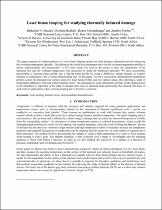JavaScript is disabled for your browser. Some features of this site may not work without it.
- ResearchSpace
- →
- Research Publications/Outputs
- →
- Conference Publications
- →
- View Item
| dc.contributor.author |
Masina, Bathusile N

|
|
| dc.contributor.author |
Bodkin, R

|
|
| dc.contributor.author |
Mwakikunga, Bonex W

|
|
| dc.contributor.author |
Forbes, A

|
|
| dc.date.accessioned | 2011-10-07T09:31:36Z | |
| dc.date.available | 2011-10-07T09:31:36Z | |
| dc.date.issued | 2011-08 | |
| dc.identifier.citation | Masina, BN, Bodkin, R, Mwakikunga, B and Forbes, A. 2011. Laser beam shaping for studying thermally induced damage. Laser Beam Shaping XII, San Diego Convention Center, San Diego, California United States, 21-22 August 2011 | en_US |
| dc.identifier.isbn | 9780819487407 | |
| dc.identifier.uri | http://spiedigitallibrary.org/proceedings/resource/2/psisdg/8130/1/81300H_1 | |
| dc.identifier.uri | http://hdl.handle.net/10204/5209 | |
| dc.description | Laser Beam Shaping XII, San Diego Convention Center, San Diego, California United States, 21-22 August 2011 | en_US |
| dc.description.abstract | This paper presents an implementation of a laser beam shaping system for both heating a diamond tool and measuring the resulting temperature optically. The influence the initial laser parameters have on the resultant temperature profiles is shown experimentally and theoretically. A CO2 laser beam was used as the source to raise the temperature of the diamond tool and the resultant temperature was measured by using the blackbody principle. The authors have successfully transformed a Gaussian beam profile into a flat-top beam profile by using a diffractive optical element as a phase element in conjunction with a Fourier transforming lens. In this paper, they have successfully demonstrated temperature profiles across the diamond tool surface using two laser beam profiles and two optical setups, thus allowing a study of temperature influences with and without thermal stress. The generation of such temperature profiles on the diamond tool in the laboratory is important in the study of changes that occur in diamond tools, particularly the reduced efficiency of such tools in applications where extreme heating due to friction is expected | en_US |
| dc.language.iso | en | en_US |
| dc.publisher | SPIE | en_US |
| dc.relation.ispartofseries | Workflow request;7361 | |
| dc.subject | Laser heating | en_US |
| dc.subject | Thermal stress | en_US |
| dc.subject | Polycrystalline diamond tools | en_US |
| dc.subject | Laser beam shaping | en_US |
| dc.title | Laser beam shaping for studying thermally induced damage | en_US |
| dc.type | Conference Presentation | en_US |
| dc.identifier.apacitation | Masina, B. N., Bodkin, R., Mwakikunga, B. W., & Forbes, A. (2011). Laser beam shaping for studying thermally induced damage. SPIE. http://hdl.handle.net/10204/5209 | en_ZA |
| dc.identifier.chicagocitation | Masina, Bathusile N, R Bodkin, Bonex W Mwakikunga, and A Forbes. "Laser beam shaping for studying thermally induced damage." (2011): http://hdl.handle.net/10204/5209 | en_ZA |
| dc.identifier.vancouvercitation | Masina BN, Bodkin R, Mwakikunga BW, Forbes A, Laser beam shaping for studying thermally induced damage; SPIE; 2011. http://hdl.handle.net/10204/5209 . | en_ZA |
| dc.identifier.ris | TY - Conference Presentation AU - Masina, Bathusile N AU - Bodkin, R AU - Mwakikunga, Bonex W AU - Forbes, A AB - This paper presents an implementation of a laser beam shaping system for both heating a diamond tool and measuring the resulting temperature optically. The influence the initial laser parameters have on the resultant temperature profiles is shown experimentally and theoretically. A CO2 laser beam was used as the source to raise the temperature of the diamond tool and the resultant temperature was measured by using the blackbody principle. The authors have successfully transformed a Gaussian beam profile into a flat-top beam profile by using a diffractive optical element as a phase element in conjunction with a Fourier transforming lens. In this paper, they have successfully demonstrated temperature profiles across the diamond tool surface using two laser beam profiles and two optical setups, thus allowing a study of temperature influences with and without thermal stress. The generation of such temperature profiles on the diamond tool in the laboratory is important in the study of changes that occur in diamond tools, particularly the reduced efficiency of such tools in applications where extreme heating due to friction is expected DA - 2011-08 DB - ResearchSpace DP - CSIR KW - Laser heating KW - Thermal stress KW - Polycrystalline diamond tools KW - Laser beam shaping LK - https://researchspace.csir.co.za PY - 2011 SM - 9780819487407 T1 - Laser beam shaping for studying thermally induced damage TI - Laser beam shaping for studying thermally induced damage UR - http://hdl.handle.net/10204/5209 ER - | en_ZA |






